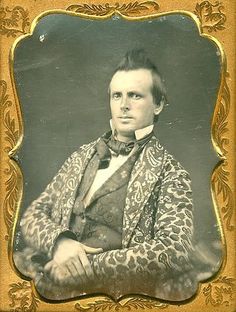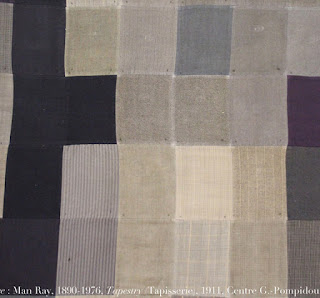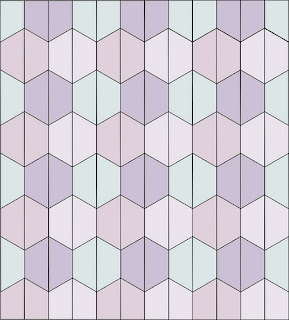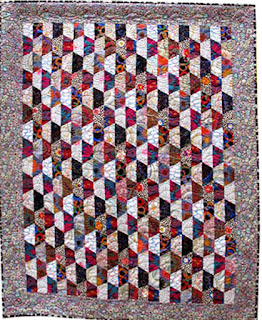Photo of an edge from the Pompidou Center's Tapestry.
We can see the wool patchwork has raw edges,
attached to the linen perhaps with the pins Man Ray used to mount it.
The caption and the photos tell us that we are looking at a patchwork top of samples of wool, about the size of a small, single bed covering. The patchwork is inscribed with the letters "S. D. B. DR." It is mounted on a piece of linen 59" inches wide and 82" long. On the linen is inscribed twice: "Man Ray 1911."
A similar wool top pieced from men's wear wools, about 1910.
Thousands of these bedcoverings
of clothing fabric rectangles were made
in the United States between 1900 and 1925.
1918 tailor's sample book with actual fabrics
glued to the page.
M. Steinthal and Sons advertised that they would cut and "book"
samples for mills and wholesalers in
Fairchild's Mens Wear Directory, 1911
Tailors' samples, menswear
The piece at the Pompidou is in a curious spot, not just because it is a mundane sample of American patchwork in a venerable position at a temple of modern art.
Similar wool sample quilt dated 1912.
The seamstress has embroidered the date and seams
with a feather stitch, a popular embroidery style from about 1880-1925.
Tapestry in a curious philosophical spot too. Is it a mundane object? Or is it a unique work of modern art because an artist has designated it as such.
Similar quilted bedcover, dated 1918,
pieced of wool squares rather than rectangles.
This one has been quilted rather than tied with yarn.
These hundred-year-old comforters are usually worth about $50 or less in today's quilt market.
They are inexpensive primarily because they are so abundant. Contrary to
this seller's advertisement, most collectors do not consider them "gorgeous."
Tapestry is generally attributed to the hand of Man Ray himself, who was born Emmanuel Radnitzky in Philadelphia to Russian Jewish immigrants Manya and Melach Radnitzky. In 1907 the Radnitzkys and their four children moved to Brooklyn. The family Americanized their last name to Ray in 1912.
I found these tiny photos of the Radnitzky/Ray parents on the web,
probably taken in the early 1940s,
posted by a cousin.
The artist grew up in a textile-centered home. His mother was a seamstress; his father was a garment worker who also did tailoring at home. Biographer Neil Baldwin describes the making of the quilt and its meaning on page 16 in Man Ray, American Artist:
Baldwin implies that Man Ray stitched the piece of 110 rectangles gathered from his father's cutting room floor when he was about 21 years old in 1911, pinned it to a sheet of canvas, and signed the canvas, "Man Ray, 1911," creating a "signal effort...as if to say 'Like the tapestries of antiquity it works as display art as well.' "
I find this scenario highly unlikely. The Radnitzky family did not change their surname to Ray until a year later but, more important, is the timing in relation to the concept of a readymade.
The reflective concept of the mundane object as art, the readymade, was a complex idea that had not yet been developed. Emanuel Radnitzky of Brooklyn did not invent it in 1911 the year before he began attending art clases at the Francisco Ferrer Social Center or Modern School.
Marcel Duchamp
Nude Descending a Staircase
Collection of the Philadelphia Museum of Art
Concepts of modern art were introduced to Americans in the 1913 Armory Show, in which French artist Marcel Duchamp's shocked viewers with his
Nude Descending a Stair Case, a piece done in the traditional medium of paint on canvas with the nontraditional concept of time inserted into a figure painting. During the teens Duchamp and other European artists in the Dada movement explored nontraditional media, for example combining two common manufactured objects and calling it art..
One of several renditions of Duchamp's Bicycle Wheel,
an idea the Dada-ists called Readymades.
Duchamp, the most famous creator of readymades, recalled his first readymade---a found object or assemblage as sculpture:
From
Essays on Assemblage (New York: The Museum of Modern Art, 1992):
“ ' In 1913,' recalled Marcel Duchamp, 'I had the happy idea to fasten a bicycle wheel to a kitchen stool and watch it turn.' ”
Bicycle Wheel in Duchamp's New York studio about 1917.
Read more about the piece here:
http://www.toutfait.com/issues/issue_2/Letters/ghalem_119.html
Alfred Steiglitz's 1917 photo of the urinal
signed "R. Mutt 1917" by Duchamp
In 1917 while living in New York, Duchamp placed a porcelain urinal on a pedestal, signed it and called it "Fountain." Man Ray and Duchamp collaborated in photographic projects in New York. After Duchamp returned to Paris in 1921, Man Ray joined him there in July, where according to a biographical timeline, "Marcel Duchamp introduces him to Dadists."
http://imageexchange.com/exhibits/manray/intro1.shtml
Surely the work of Duchamp and other artists in the Dada movement influenced Man Ray into mounting a patchwork quilt top and calling it a
Tapestry. But when?
The Pompidou Center shows this photo of Man Ray's studio dated 1919 in New York
with the patchwork top "Tapestry" on the wall near the window.
He moved to Paris in 1921, so if the date is correct the photograph was shot in his studio in New York or New Jersey where he worked from 1916 to 1921. However, the windows and balcony look more like a Parisian flat. The patchwork top appears to be unmounted, perhaps tacked to the wall in the top corners.
Self-Portrait Man Ray, 1932.
He was primarily an innovative photographer,
but also, as he said, an object maker.
Biographer Neil Baldwin interviewed musician Virgil Thomson, who remembered meeting Man Ray in Paris in 1921. Thomson "was impressed initially by the sight of
Tapestry hanging on the artist's studio wall, recalling it years later as a 'cubist quilt.' " Based on the room's architecture and Thomson's memory, one would guess the photo above is most likely the Paris studio of 1921 rather than the New York studio of 1919.
At that point the "cubist quilt" was being displayed as a work of art. My guess is that Man Ray took the piece to France. Travelers have often packed quilts in their luggage. Beyond bedding, they provide memories of the hands that made them. A third function takes it away from functional: Man Ray enjoyed viewing it on the wall rather than on the bed. He later took the relationship between utilitarian object and art further by stitching or pinning the top to a larger piece of linen, signing the linen mount in the style of Duchamp: "Man Ray 1911"
Baldwin also mentions that the quilt stayed with the artist through his move to Los Angeles in 1940 when he and Juliet Browner rented a two-story apartment in Hollywood.
"One of Man Ray's first decorative decisions was to drape the 1911 Tapestry...over the railing, where it would be noticed by every visitor, a constant reminder of how he had begun."
Did Man Ray make the patchwork top in 1911?
According to the Pompidou Center's caption, the quilt itself is inscribed with the initials "S.D.B.DR" but no date. The Radnitzky family of four children were named Emmanuel (born 1890), Samuel (1893), Devora or Dorothy (1895) and Elka or Elsie (1897).
Did DR stand for Devora Radnitzky who was 16 years old in 1911?
Portrait of Dorothy by Man Ray, signed
1911 but ca. 1912
from Nauman's book and the Man Ray Trust
Francis M. Naumann in his 2003 book Conversion to Modernism: The Early Work of Man Ray,
recorded her memories:
"Dorothy, his younger sister, recalls that their home was always cluttered with remnants from their father's profession: cloth samples and scraps of material, which their mother often stitched together to make carriage blankets and quilts. The children also became involved in the making of these items, and at a very early age they - boys included - were taught to piece together material, sew, and embroider. As we shall see, this domestic experience appears to have had a particularly lasting effect on young Emmanuel, for he would later employ similar techniques in the making of his mature paintings and collages."
Cloth sample book from 1911-1912
containing rectangular samples of wool glued onto the page.
Tailors continue to show customers their choices in this format.
The story of
Tapestry and its origins as his first view of modernism has become intrinsic to the story of Man Ray. As a quilt historian I feel the art historians have been reading far too much into the object. It was in 1911 an object, a quilt, not an object labeled a work of art, a tapestry.
Emmanuel Radnitzky could very well have made the actual quilt top, but his mother is my chief candidate as seamstress. Baldwin begins his biography with a description of a silk crazy quilt Manya Radnitzky made for her first-born in 1890, at the height of the crazy quilt fad. He describes her interest in needlework:
"Satisfying handiwork for her, was to sit down with a bundle of threads and some rags, relying upon her resourceful imagination to create something of beauty. She made all her children's clothes."
My position on
Tapestry:
Man Ray brought this unfinished quilt top with him to Paris in 1921. It may have been made by his mother or as a family project in 1911, at the height of the fashion for patchwork made of tailors' sample swatches.
The artist hung the quilt top on the wall of his Paris studio. At some point he saw the quilt with its muted color and minimal shapes as more art than functional bedcovering. He went beyond that and attached it to a linen support, signing the linen "Man Ray, 1911"
Man Ray and Juliet Man Ray's tombstones
in Paris's Montparnasse Cemetery.
Note Juliet was born in 1911 the year of Tapestry
Man Ray and Juliet Browner (1911-1991) married in 1946. After the artist's death in 1976 Juliet Man Ray hoped to open a museum in their Paris studio, a dream never achieved. Her New York Times obituary noted: "Most of the contents are now stored at the Pompidou Center." Tapestry has an acquisition number indicating it went into the collection in 1994. After Juliet's death her brother and family inherited the collection (minus Tapestry, which presumably is still at the Pompidou).
See a 2012 article from the
Wall Street Journal about the collection here:
Man Ray, Tapestry, 1973
Print edition of 100, signed in pencil.
Published by Ed. Astrid, Varese.
In 1973, Man Ray reflected on the wool patchwork again with a print of a similar composition, also called Tapestry.
A few references:
Conversion to Modernism: The Early Work of Man Ray, Francis M. Naumann and Gail Stavitsky. Montclair Art Museum.
http://www.tfaoi.com/aa/3aa/3aa655.htm
John Elderfield, ed.,
Studies in Modern Art 2: Essays on Assemblage (New York: The Museum of Modern Art, 1992), page 135.
"Emmanuel Radnitzky Before He Was Man Ray,"
New York Times, March 7, 2003.
http://www.nytimes.com/2003/03/07/arts/art-review-emmanuel-radnitzky-before-he-was-man-ray.html
Man Ray, American Artist, Neil Baldwin. Clarkson N. Potter, 1988





















































































